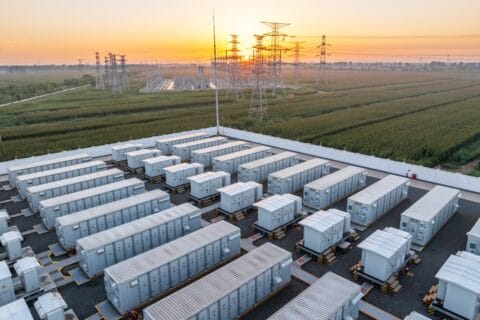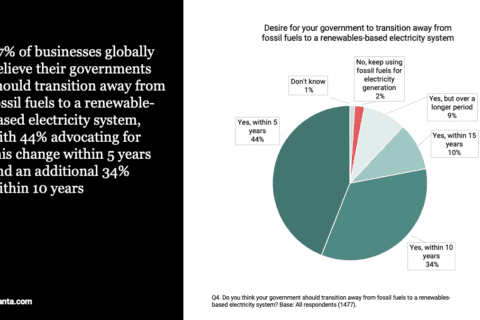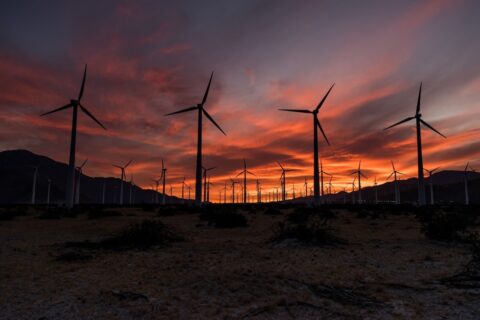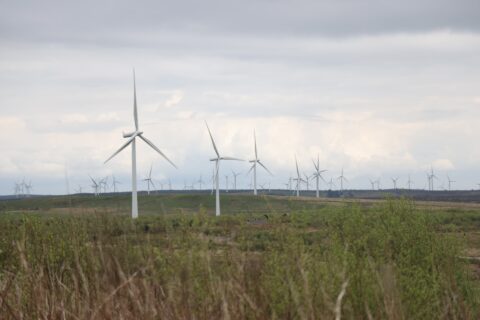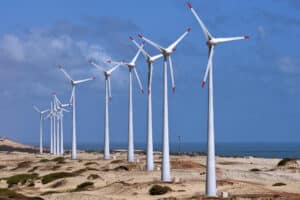
Image: Adriano Machado/Bloomberg News
The world committed a record $501.3bn to decarbonisation in 2020, beating the previous year by 9%, despite the economic disruption caused by the COVID-19 pandemic. These latest figures from the newly released Energy Transition Investment Trends report, published by BloombergNEF (BNEF), reveal that global investment in renewable energy capacity topped $300bn again in 2020, recording the second-highest annual figure ever and the seventh consecutive total of more than $250bn.
The report is BloombergNEF’s annual accounting of global investment in the low-carbon energy transition. Previously focused on renewables, the report now includes investment figures for a wider scope of transition areas, including energy storage, electrified vehicles and heating, hydrogen, and carbon capture and storage. It also covers thematic highlights such as the rise of green finance, performance of clean energy stocks and investment by oil majors.
BNEF’s analysis shows that companies, governments and households invested $303.5bn in new renewable energy capacity in 2020, up 2% on the year — helped by the biggest-ever build-out of solar projects and a $50bn surge for offshore wind. They also spent $139bn on electric vehicles and associated charging infrastructure, up 28% and a new record.
Other areas of energy transition investment also showed strength. Domestic installation of energy-efficient heat pumps came to $50.8bn, up 12%; while investment in stationary energy storage technologies such as batteries was $3.6bn, level with 2019 despite falling unit prices. Global investment in carbon capture and storage (CCS) tripled to $3bn; and that in hydrogen was $1.5bn, down 20% but the second-highest annual number to date (see Figure 1).
Calling for greater ambition around investment, Albert Cheung, head of analysis at BNEF, said:
“Our figures show that the world has reached half a trillion dollars a year in its investment to decarbonise the energy system. Clean power generation and electric transport are seeing heavy inflows, but need to see further increases in spending as costs fall. Technologies such as electric heat, CCS and hydrogen are only attracting a fraction of the investment they will need in the 2020s to help bring emissions under control. We need to be talking about trillions per year if we are to meet climate goals.”
A geographical split of BNEF’s energy transition investment data shows that Europe accounted for the biggest slice of global investment, at $166.2bn (up 67%), with China at $134.8bn (down 12%) and the US at $85.3bn (down 11%). Europe’s impressive performance was driven by a record year for electric vehicle sales, plus the best year in renewable energy investment since 2012.
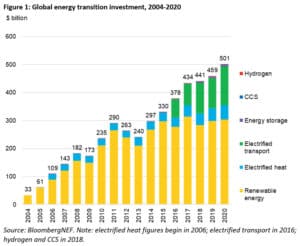
On net zero, Jon Moore, chief executive of BNEF, said:
“The coronavirus pandemic has held back progress on some projects, but overall investment in wind and solar has been robust and electric vehicle sales jumped more than expected. Policy ambition is clearly rising as more countries and businesses commit to net-zero targets, and green stimulus programmes are starting to make their presence felt. Some 54% of 2016 emissions are now under some form of net-zero commitment, up from 34% at the start of last year. This should drive increasing investment in the coming years.”
Record renewable energy investment
Total global investment in renewable energy capacity moved up 2% to $303.5bn in 2020. This was the second-highest annual figure ever (after 2017’s $313.3bn), and the seventh consecutive total of more than $250bn. Falling capital costs enabled record volumes of both solar (132GW) and wind (73GW) to be installed on the basis of the modest increase in dollar investment.
Highlights of the renewables investment total included a leap of 56% in financings of offshore wind projects to $50bn, including the largest deal ever in that sub-sector — $8.3bn for the 2.5GW Dogger Bank project in the UK North Sea. The year also saw the largest single solar park ever funded, the 2GW Al Dhafrah in the United Arab Emirates, at a cost of $1.1bn.
Overall, solar capacity investment was up 12% at $148.6bn, and wind (onshore and offshore) down 6% at $142.7bn. Biomass and waste-to-energy financings were down 3% at $10bn.
In terms of regions, renewable energy capacity investment in Europe, at $81.8bn, up 52%, was its highest since 2012 and almost caught up with China, at $83.6bn, down 12%. The US fell 20% to $49.3bn, as wind investment almost halved, and India slipped 36% to $6.2bn.
Renewables capacity investment rose 10% in Japan to $19.3bn; 177% in the UK to $16.2bn; and 221% in the Netherlands to $14.3bn. Spain was up 16% at $10bn; Brazil up 23% at $8.7bn; Vietnam 89% higher at $7.4bn; France 38% up at $7.3bn; and Germany 14% up at $7.1bn. Other markets seeing $3 billion-plus totals included Taiwan, Australia, South Korea, Poland, Chile, Turkey and Sweden.
Public markets, Venture Capital & Private Equity
BloombergNEF also continues to track investment by the public markets and venture capital and private equity players in renewable energy and the closely related area of energy storage. In 2020, specialist companies in these areas raised a runaway record figure of $20bn via share issues on public markets, up 249% on the previous year.
The biggest deals included $2.8bn raised by Chinese battery maker Contemporary Amperex Technology (CATL); $846M from US fuel cell company Plug Power; and $777M from Chinese PV manufacturer JA Solar Technology.
Venture capital and private equity investment in renewables and storage increased 51% to $5.9bn last year. Both this, and investment via the public markets, took place against the backdrop of buoyant share prices: the WilderHill New Energy Global Innovation Index (NEX), which tracks about 100 clean energy stocks worldwide, rose 142% in 2020 to record levels.
This positive investor mood helped electric vehicle companies raised some $28bn from stock market investors in 2020, up from just $1.6bn in 2019, according to BNEF estimates. Last year’s total was seven times the previous record, in 2016.
BloombergNEF (BNEF) is a leading provider of primary research on clean energy, advanced transport, digital industry, innovative materials, and commodities. With a team of experts spread across six continents, BNEF leverages the world’s most sophisticated data sets to create clear perspectives and in-depth forecasts that frame the financial, economic and policy implications of industry-transforming trends and technologies. Available online, on mobile and on the Terminal, BNEF is powered by Bloomberg’s global network of 19,000 employees in 176 locations, reporting 5,000 news stories a day.
Further Reading:
- More about the Energy Transition Investment Trends report, including free summary download;
- More about BloombergNEF (BNEF); and Bloomberg the company;
- Also on SustMeme, Top 5 technologies disrupting the energy industry in 2021;
- Also on SustMeme, World’s biggest vanadium flow battery will time-shift solar in Australia;
- Also on SustMeme, Solar and wind now cheapest for 2 in 3 people worldwide;
- Also on SustMeme, World’s first hydrogen double-decker bus unveiled in Aberdeen;
- Also on SustMeme, $3.4 trillion to be invested in renewable energy by 2030;
- Also on SustMeme, Clean energy outperforms dirty power stocks but lacks size;
- Also on SustMeme, Hydrogen can clean up by 2050;
- Also on SustMeme, World first for solar in Lithuania;
- Also on SustMeme, Guest Blog: Testing the future of grid-integrated renewables.;
- Also on SustMeme, Guest Blog: What impact has COVID-19 had on the energy sector?
Check out the full archive of stories on the SustMeme Climate & Energy Channel, now available to Sponsor.

